Pseuduvaria cerina is a species of tree in the Annonaceae family. It is endemic to Peninsular Malaysia. James Sinclair, the Scottish botanist who first formally described the species, named it after its waxy yellow inner petals.
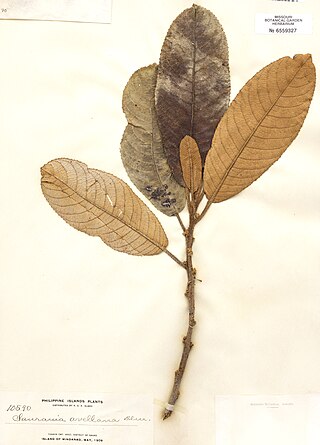
Saurauia avellana is a species of plant in the Actinidiaceae family. It is native to the Philippines. Adolph Daniel Edward Elmer, the American botanist who first formally described the species, named it after the dense covering of hazel-colored downy hair covering the underside of its leaves.

Saurauia clementis is a species of flowering plant in the family Actinidiaceae. It is endemic to the Philippines. Elmer Drew Merrill, the American botanist who first formally described the species, named it after Mary Strong Clemens, the American botanist who collected the specimen that he examined.

Saurauia copelandii is a species of plant in the Actinidiaceae family. It is native to the Philippines. Adolph Daniel Edward Elmer, the American botanist who first formally described the species, named it in honor of Edwin Copeland, another American botanist who collected many botanical samples in the Philippines.
Saurauia glabra is a species of plant in the Actinidiaceae family. It is native to Borneo. Elmer Drew Merrill, the American botanist who first formally described the species, named it after its hairlessness.
Saurauia klemmei is a species of plant in the family Actinidiaceae. It is native to the Philippines. Elmer Drew Merrill, the American botanist who first formally described the species, named it after Wilhelm Klemme, a German forest officer, who collected the specimen Merrill examined from Luzon island in the Philippines.

Saurauia papillulosa is a species of flowering plant in the family Actinidiaceae. It is endemic to the Philippines where it is known as papayang. Elmer Drew Merrill, the American botanist who first formally described the species, named it after the distinctive abundant small bumps, or papillae, on the underside of its leaves.

Saurauia sparsiflora is a species of flowering plant in the family Actinidiaceae. It is endemic to the Philippines. It was discovered on Mount Santo Tomas by Adolph Daniel Edward Elmer, the American botanist who first formally described the species, and named it after the small number, or sparse, flowers in its inflorescences.
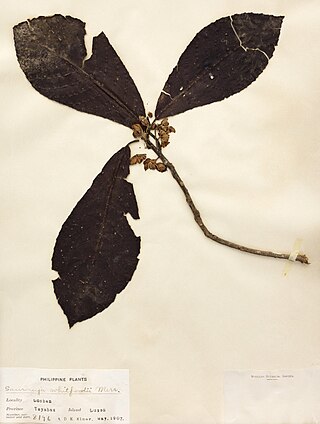
Saurauia whitfordii is a species of plant in the Actinidiaceae family. It is native to the Philippines. Elmer Drew Merrill, the American botanist who first formally described the species, named it after Harry Nichols Whitford, another American botanist who collected the specimen Merrill examined.
Goniothalamus puncticulifolius is a species of plant in the family Annonaceae. It is native to Borneo and The Philippines. Elmer Drew Merrill, the American botanist who first formally described the species, named it after its minutely spotted leaves.
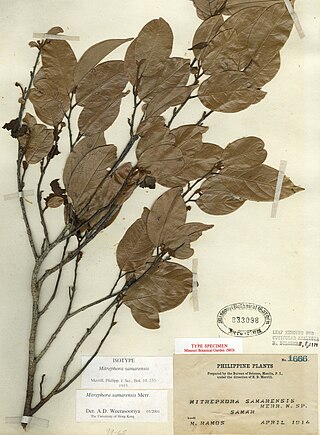
Mitrephora samarensis is a species of plant in the family Annonaceae. It is native to the Philippines. Elmer Drew Merrill, the American botanist who first formally described the species, named it after Samar, the third largest island in the Philippines, where the sample he examined was collected.
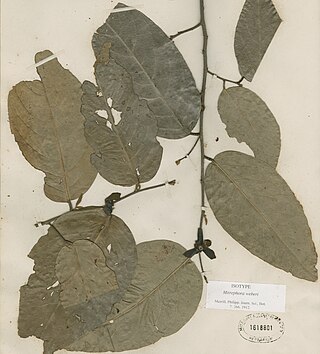
Mitrephora weberi is a species of plant in the family Annonaceae. It is native to The Philippines. Elmer Drew Merrill, an American botanist, first formally described the species and named it after Charles Martin Weber who collected the specimen that Merrill examined.
Duckeanthus is a genus of plant in the family Annonaceae. It is native to Brazil. It contains a single species, Duckeanthus grandiflorus. Robert Elias Fries, the Swedish botanist who first formally described it, named it in honor of Adolpho Ducke who collected the specimen he examined, and its large flowers.
Pseuduvaria luzonensis is a species of plant in the family Annonaceae. It is native to The Philippines. Elmer Drew Merrill, the American botanist who first formally described the species using the synonym Orophea luzoniensis, named it after Luzon in the Province of Battan, Philippines where the specimen he examined was collected along the Lamao River.
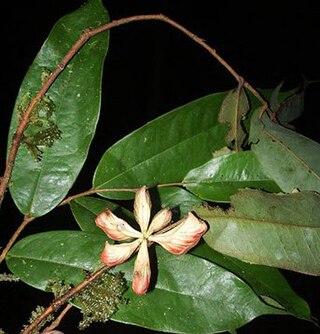
Xylopia cuspidata is a species of plant in the Annonaceae family. It is native to Bolivia, Brazil, Colombia, Ecuador and Peru. Ludwig Diels, the botanist who first formally described the species, named it after the leaves which have an abruptly pointed tip.
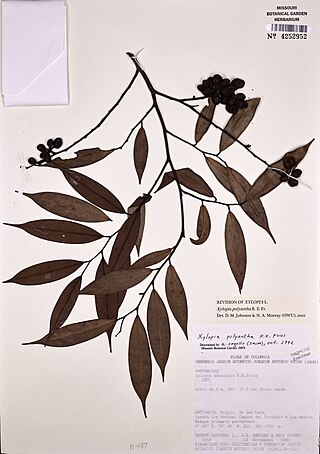
Xylopia polyantha is a species of plant in the Annonaceae family. It is native to Bolivia, Brazil, Colombia, Ecuador, and Peru. Robert Elias Fries, the botanist who first formally described the species, named it after its many flowers.
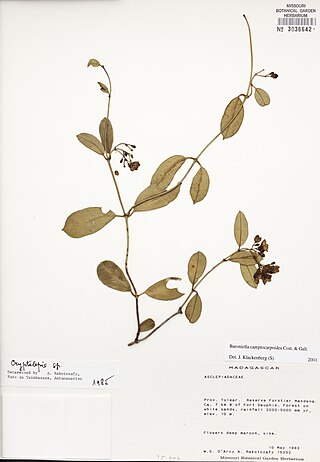
Baroniella camptocarpoides is a species of plant in the Apocynaceae family. It is endemic to Madagascar. Julien Noël Costantin and Ernest-Isidore Gallaud, the botanists who first formally described the species, named it after its resemblance to, but distinctiveness from, plants in the genus Camptocarpus.

Condylocarpon guyanense is a species of plant in the Apocynaceae family. It is native to Brazil, French Guiana, and Guyana. René Louiche Desfontaines, the botanist who first formally described the species, named it after Guyana where Joseph Martin collected the specimen he examined.

Condylocarpon isthmicum is a species of plant in the Apocynaceae family. It is native to Argentina, Brazil, Paraguay and Uruguay. José Mariano de Conceição Vellozo, the botanist who first formally described the species, named it after the narrow neck connecting the two sections of its fruit.
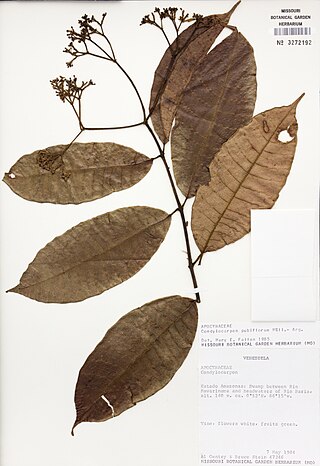
Condylocarpon pubiflorum is a species of plant in the Apocynaceae family. It is native to Bolivia, Brazil, Colombia, Peru and Venezuela. Johannes Müller Argoviensis, the botanist who first formally described the species, named it after an invalid nomen nudum, Hortsmania pubiflora, previously offered by George Bentham.














